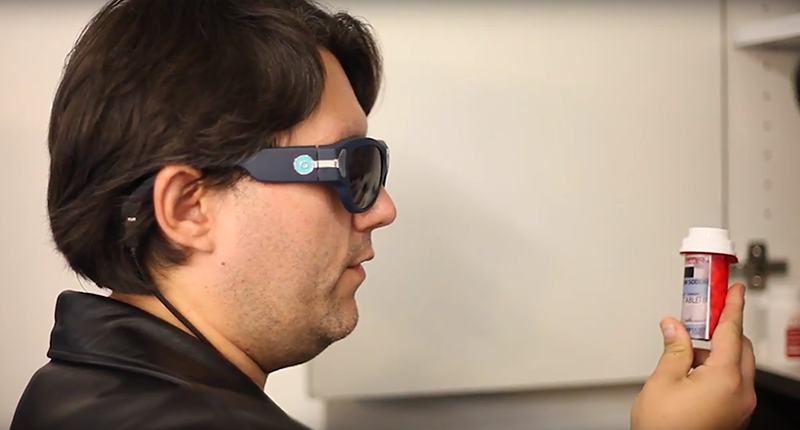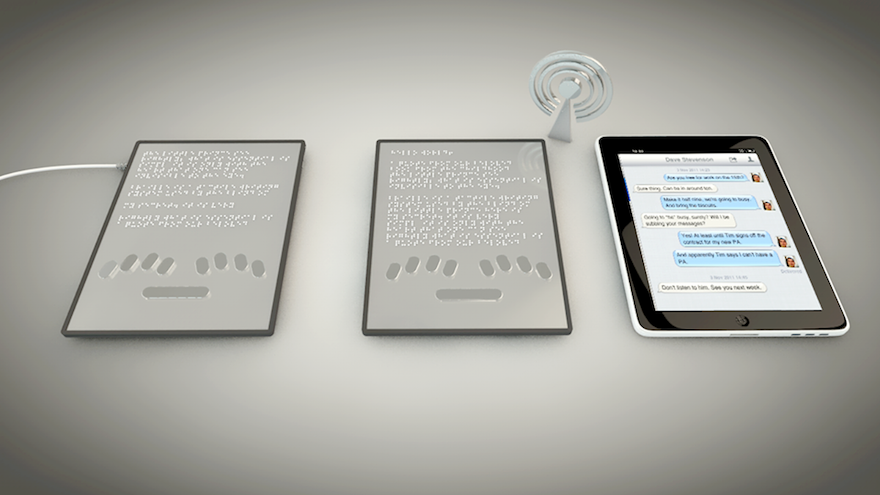Discover Cutting-edge Devices Created for the Aesthetically Impaired
The development of cutting-edge devices for the aesthetically impaired represents a considerable advancement in ease of access and independence. Technologies such as clever glasses with AI capabilities and mobile applications made to supply auditory descriptions are improving daily experiences for customers. In addition, wearable tools that employ haptic responses boost environmental awareness, while modern Braille innovations provide new means to involve with text. As these devices proceed to advance, their effect on the lives of those with visual impairments elevates crucial concerns regarding the future of inclusivity and autonomy in numerous facets of life. What exists in advance in this technical landscape?
Smart Glasses for Navigating

Smart glasses designed for navigation are revolutionizing the method visually impaired people communicate with their setting. These advanced tools use a combination of video camera modern technology, expert system, and acoustic responses to supply real-time information regarding environments. By employing barrier detection systems, smart glasses can signal individuals to possible hazards, making it possible for safer movement in both familiar and strange setups.
The assimilation of GPS innovation further boosts navigating capabilities, allowing users to get auditory instructions as they move. This hands-free strategy not only fosters self-reliance but likewise encourages visually damaged individuals to browse urban landscapes with enhanced self-confidence. In addition, numerous smart glasses are geared up with attributes that recognize landmarks and street signs, giving contextual details that enhances the user experience.
In addition, the advancement of these devices is constantly advancing, with business functioning to boost the accuracy of item recognition and increase the series of navigational attributes. As clever glasses become more cost effective and obtainable, they hold the possible to significantly transform every day life for aesthetically impaired customers. Inevitably, these cutting-edge tools represent a crucial action toward inclusivity, offering enhanced mobility and a better feeling of freedom for individuals browsing the globe around them.

Mobile Apps for Daily Living
How can mobile applications improve the day-to-days live of aesthetically impaired individuals? Mobile applications are revolutionizing the way visually impaired users browse their atmospheres, handle everyday jobs, and access info. These applications give vital assistance through different capabilities, cultivating self-reliance and boosting lifestyle.
Numerous cutting-edge mobile applications are created specifically for everyday living. Applications like Be My Eyes connect visually impaired users with sighted volunteers using video calls, enabling them to get real-time support with tasks such as reviewing labels or browsing strange spaces. Similarly, Seeing AI, created by Microsoft, makes use of expert system to describe environments, checked out text, and recognize things, properly changing a mobile phone into a powerful device for day-to-day support.
In addition, navigating apps customized for the aesthetically damaged, such as Aira and BlindSquare, provide audio-based directions and environmental information, making it possible for users to traverse their surroundings safely and confidently. Beyond navigation and prompt aid, mobile applications also support organization and job monitoring, with functions that help individuals set tips, produce order of business, and track consultations. In summary, mobile applications work as crucial resources, encouraging aesthetically impaired people to lead more independent and fulfilling lives.
Wearable Technologies for Support
Empowerment through innovation is increasingly apparent see here in the world of wearable tools developed to aid aesthetically impaired people. These ingenious tools incorporate seamlessly into life, improving navigating and providing essential comments to individuals. For instance, clever glasses outfitted with cams can check out and recognize faces text aloud, permitting customers to interact even more confidently in social and expert settings.
Another noteworthy development is using haptic comments systems in wearable gadgets. These systems make use of resonances or other tactile signals to communicate info regarding the customer's setting, such as challenges or adjustments in terrain, boosting wheelchair and safety. Wearable modern technologies also include wristbands that link to smartphones, notifying customers to notices with refined vibrations, hence improving connectivity without dependence on aesthetic hints.
As these innovations remain to progress, they are not just boosting freedom for aesthetically damaged individuals but also fostering a higher sense of addition in culture. By linking the space between obstacles encountered in daily living and the capacity for freedom, wearable technologies act as pivotal tools in the quest for equal rights and empowerment for those with visual impairments.
Sound Summary Tools
Sound summary devices play a critical duty in improving access for aesthetically impaired individuals, offering them with the capability to engage with aesthetic media. Voice-activated assistive devices. These devices use narrated summaries of crucial visual elements in films, tv shows, and live efficiencies, ensuring that users can totally comprehend the context and emotions shared via visuals
Audio description can be integrated into various platforms, consisting of streaming services, cinema testings, and live theater. Several prominent streaming services currently include audio description as an availability attribute, allowing customers to pick it easily. In enhancement to conventional media, specialized applications additionally exist, offering audio summaries for art events, galleries, view publisher site and other social events.
The effectiveness of audio description pivots on the skill of the narrators, that must share visual details succinctly without interfering with the original audio. Developments in this field are likewise leading the method for more personalized experiences, where users can readjust the level of detail and pacing according to their preferences.
Braille Innovations and Devices
Braille advancements and tools have actually dramatically transformed the method aesthetically impaired individuals engage with message and information. Modern improvements have actually led to the development of flexible tools that improve proficiency and self-reliance among customers.
In addition, portable Braille notetakers combine standard Braille input with contemporary performances, assisting in note-taking, scheduling, and file modifying on the go. AI-powered visual aids. These small devices often include text-to-speech capabilities, linking the space in between Braille and acoustic details
In addition, innovative Braille printers have actually emerged, permitting individuals to create Braille labels, papers, and educational materials efficiently. This accessibility promotes check my blog better engagement in expert and academic environments, ultimately promoting inclusivity.
In addition, research study into smart Braille technologies proceeds to increase. Tools that incorporate fabricated intelligence are being discovered to supply real-time navigating aid and contextual info, enhancing the customer experience in varied settings. Overall, these developments mirror a commitment to equipping aesthetically damaged individuals via innovation, guaranteeing they can quickly access and engage with the world around them.

Final Thought
The innovation of ingenious tools for the aesthetically impaired significantly boosts freedom and top quality of life. These technologies not just foster higher inclusion yet likewise advertise autonomy in day-to-day tasks, inevitably adding to a more fair and easily accessible society for aesthetically damaged people.
As smart glasses come to be extra easily accessible and cost effective, they hold the possible to dramatically change daily life for visually damaged users. Mobile applications are revolutionizing the method aesthetically damaged individuals browse their environments, handle daily jobs, and accessibility info. Applications like Be My Eyes attach visually damaged users with sighted volunteers using video calls, permitting them to receive real-time aid with tasks such as checking out tags or navigating strange spaces.Furthermore, navigation apps customized for the aesthetically impaired, such as Aira and BlindSquare, offer audio-based directions and ecological information, allowing customers to traverse their surroundings securely and with confidence.The improvement of cutting-edge devices for the aesthetically damaged considerably enhances self-reliance and high quality of life.
Comments on “AI-Powered Visual Aids: Redefining Support for the Blind”